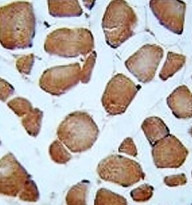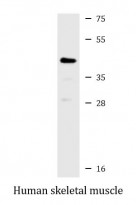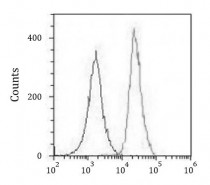ARG59372
anti-ANGPTL4 antibody
anti-ANGPTL4 antibody for Flow cytometry,IHC-Formalin-fixed paraffin-embedded sections,Western blot and Human
Overview
| Product Description | Rabbit Polyclonal antibody recognizes ANGPTL4 |
|---|---|
| Tested Reactivity | Hu |
| Predict Reactivity | Ms |
| Tested Application | FACS, IHC-P, WB |
| Host | Rabbit |
| Clonality | Polyclonal |
| Isotype | IgG |
| Target Name | ANGPTL4 |
| Antigen Species | Human |
| Immunogen | KLH-conjugated synthetic peptide corresponding to aa. 138-167 of Human ANGPTL4. |
| Conjugation | Un-conjugated |
| Alternate Names | UNQ171; NL2; pp1158; FIAF; Angiopoietin-like protein 4; TGQTL; Hepatic fibrinogen/angiopoietin-related protein; Angiopoietin-related protein 4; ARP4; PGAR; HFARP; HARP |
Application Instructions
| Application Suggestion |
|
||||||||
|---|---|---|---|---|---|---|---|---|---|
| Application Note | * The dilutions indicate recommended starting dilutions and the optimal dilutions or concentrations should be determined by the scientist. | ||||||||
| Positive Control | Human skeletal muscle |
Properties
| Form | Liquid |
|---|---|
| Purification | Saturated Ammonium Sulfate (SAS) precipitation followed by dialysis against PBS. |
| Buffer | PBS and 0.09% (W/V) Sodium azide. |
| Preservative | 0.09% (W/V) Sodium azide. |
| Storage Instruction | For continuous use, store undiluted antibody at 2-8°C for up to a week. For long-term storage, aliquot and store at -20°C or below. Storage in frost free freezers is not recommended. Avoid repeated freeze/thaw cycles. Suggest spin the vial prior to opening. The antibody solution should be gently mixed before use. |
| Note | For laboratory research only, not for drug, diagnostic or other use. |
Bioinformation
| Database Links | |
|---|---|
| Gene Symbol | ANGPTL4 |
| Gene Full Name | angiopoietin-like 4 |
| Background | This gene encodes a glycosylated, secreted protein containing a C-terminal fibrinogen domain. The encoded protein is induced by peroxisome proliferation activators and functions as a serum hormone that regulates glucose homeostasis, lipid metabolism, and insulin sensitivity. This protein can also act as an apoptosis survival factor for vascular endothelial cells and can prevent metastasis by inhibiting vascular growth and tumor cell invasion. The C-terminal domain may be proteolytically-cleaved from the full-length secreted protein. Decreased expression of this gene has been associated with type 2 diabetes. Alternative splicing results in multiple transcript variants. This gene was previously referred to as ANGPTL2 but has been renamed ANGPTL4. [provided by RefSeq, Sep 2013] |
| Function | Protein with hypoxia-induced expression in endothelial cells. May act as a regulator of angiogenesis and modulate tumorigenesis. Inhibits proliferation, migration, and tubule formation of endothelial cells and reduces vascular leakage. May exert a protective function on endothelial cells through an endocrine action. It is directly involved in regulating glucose homeostasis, lipid metabolism, and insulin sensitivity. In response to hypoxia, the unprocessed form of the protein accumulates in the subendothelial extracellular matrix (ECM). The matrix-associated and immobilized unprocessed form limits the formation of actin stress fibers and focal contacts in the adhering endothelial cells and inhibits their adhesion. It also decreases motility of endothelial cells and inhibits the sprouting and tube formation (By similarity). [UniProt] |
| Cellular Localization | Secreted. Secreted, extracellular space, extracellular matrix. Note=The unprocessed form interacts with the extracellular matrix. This may constitute a dynamic reservoir, a regulatory mechanism of the bioavailability of ANGPTL4 (By similarity). [UniProt] |
| Calculated MW | 45 kDa |
| PTM | N-glycosylated. [UniProt] |
Images (3) Click the Picture to Zoom In
-
ARG59372 anti-ANGPTL4 antibody IHC-P image
Immunohistochemistry: Formalin-fixed and paraffin-embedded Human skeletal muscle stained with ARG59372 anti-ANGPTL4 antibody.
-
ARG59372 anti-ANGPTL4 antibody WB image
Western blot: 20 µg of Human skeletal muscle lysate stained with ARG59372 anti-ANGPTL4 antibody at 1:1000 dilution.
-
ARG59372 anti-ANGPTL4 antibody FACS image
Flow Cytometry: A549 cells were fixed with 2% paraformaldehyde (10 min) and then permeabilized with 90% methanol for 10 min. The cells were then incubated in 2% BSA to block non-specific protein-protein interactions followed by ARG59372 anti-ANGPTL4 antibody (right histogram) at 1:25 dilution for 60 min at 37°C, followed by DyLight®488 labelled secondary antibody. Isotype control antibody (left histogram) was Rabbit IgG (1 µg/10^6 cells) used under the same conditions. Acquisition of > 10000 events was performed.








